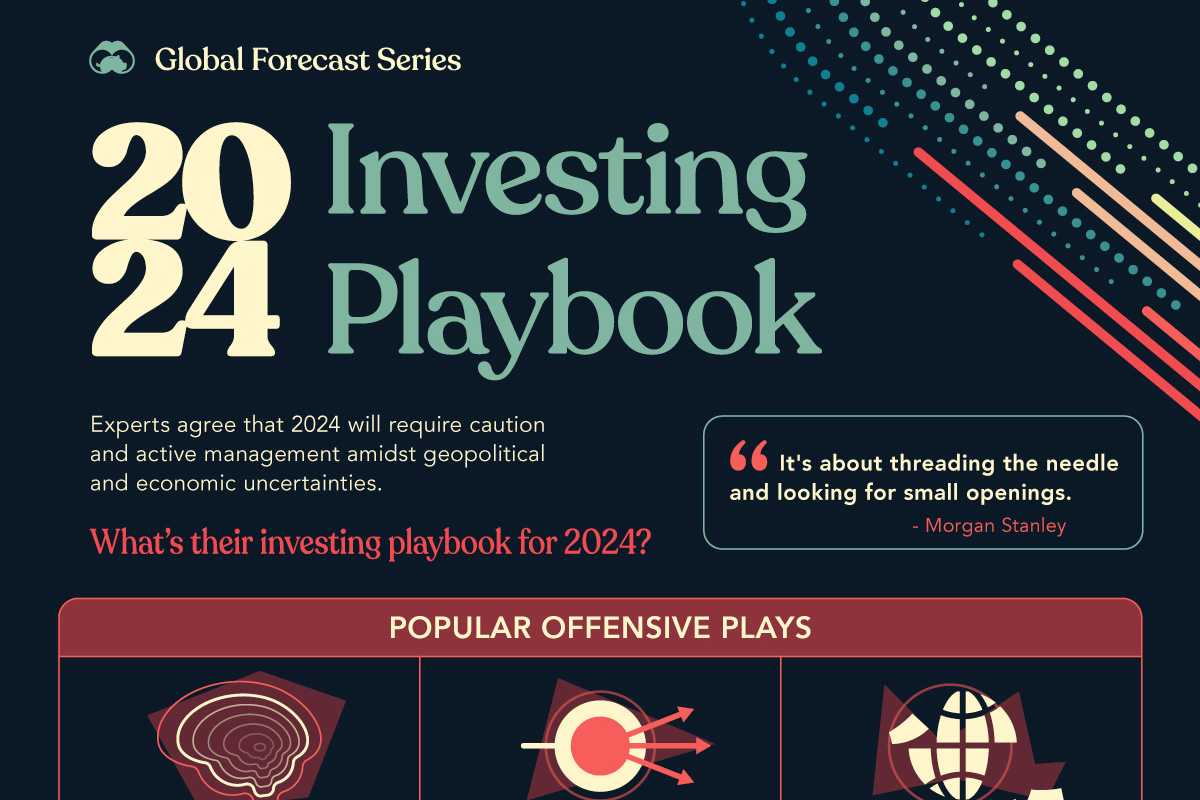
How Are Top Investment Banks Investing in 2024?
As investors look ahead to next year’s global economic environment of higher interest rates and heightened geopolitical fragmentation, growth concerns and unexpected volatility present new challenges.
With many top banks advising on putting capital to work while urging caution and active management of portfolios for 2024, which investment strategies and assets are they looking at for the upcoming year?
This graphic compiles insights from the 2024 investment outlooks of various major institutions like Goldman Sachs, J.P. Morgan, UBS, and more into a single investing playbook for next year. From their core defensive holdings to the more aggressive investing themes they’re eyeing, here’s what many of the top banking institutions agree on for next year.
Deploy Capital But Stick to Quality Bonds and Stocks
Investing capital in 2024 presents its challenges and risks, however, many top investment banks are in consensus that the new macroeconomic environment of higher interest rates and unsettled inflation (which could surge again) renders holding cash equally risky.
Many outlooks suggest going back to basics for deploying cash into core holdings: high quality bonds to lock in elevated yields and recession-resilient equities with strong balance sheets.
“In our view, government bond markets are overpricing the risk that high interest rates will represent the new normal, and we also expect yields to fall in 2024. This speaks in favor of limiting cash allocations and locking in yields in quality bonds.”
– UBS
With interest rates likely at their peak as cuts forecasted by many (including the Federal Reserve) for 2024, real and nominal bond yields offer security with attractive income prospects.
Institutions like BlackRock and Bank of America highlight the opportunity found in inflation-linked bonds like Treasury Inflation-Protected Securities (TIPS), which offer decent income at around 2% across various durations while also insulating against the potential for sticky or surging inflation.
“Earning a positive, substantial yield after inflation on U.S. government-guaranteed securities is a welcome relief for savers after years of financial repression.”
– BANK OF AMERICA
When it comes to equities, many institutions are favoring large-caps with strong balance sheets that can withstand a possible contraction in earnings should a recession materialize.
“We think that in a “higher rates for longer” world, strong balance sheet companies and larger companies probably still have scope to extend their outperformance on average.”
– GOLDMAN SACHS
Artificial Intelligence Offers Outsized Opportunity
If there’s one common investment theme many institutions are willing to be aggressive on, it’s the outsized potential opportunity artificial intelligence offers the market.
From the mega-cap AI leaders which defined the past year like Microsoft, Meta, and Alphabet to the underlying hardware and data center providers, the continuous progression of artificial intelligence and its infrastructure offers various investment avenues.
“The most obvious beneficiaries of the generative AI revolution have already seen an expanded growth in their market cap in 2023, but there are potential opportunities as we enter the next stages of buildout.”
– CITI
The variety in the supporting layers of AI’s tech stack like cloud and data infrastructure has many favoring the tech sector overall in 2024.
Investors willing to take more risk in search of specific industry exposure can look at niches with the highest potential to reap AI’s productivity benefits and downstream effects like fintech, robotics, and cybersecurity.
“We see the tech sector’s earnings resilience persisting and expect it to be major driver of overall U.S. corporate profit growth in 2024.”
– BLACKROCK
Global Diversification Amidst Geopolitical Fragmentation
While the now familiar fractured and increasingly bipolar geopolitical landscape poses plenty of risks next year, many institutions are also identifying the beneficiaries of this changing world order.
“Global diversification may add value to the portfolios as economies diverge and move at their own pace.”
– GOLDMAN SACHS
India and Mexico are top picks across many of the outlooks, as both emerging nations have strong long-term supporting catalysts. India’s strong demographics and diversity in sectors offers large growth prospects as Western supply chains and trade potentially continue to shift away from China.
Mexico, on the other hand, looks poised to further benefit from the ongoing trend of U.S. companies near-shoring manufacturing and operations, with the peso having risen 13% YTD in 2023 against the U.S. dollar due to an influx of foreign capital.
“India and Mexico are likely to benefit from a longer-term reorientation of global supply chains and consequent expansion of their domestic manufacturing capacity.”– BANK OF AMERICA
Lastly, both Japan‘s currency and its equities are a common pick for developed market diversification, with various institutions noting its appealing valuations and earnings growth bolstered by fiscal and monetary policy.
“Japanese policymakers have been an outlier among central banks, keeping interest rates low to boost growth.”
– MORGAN STANLEY







